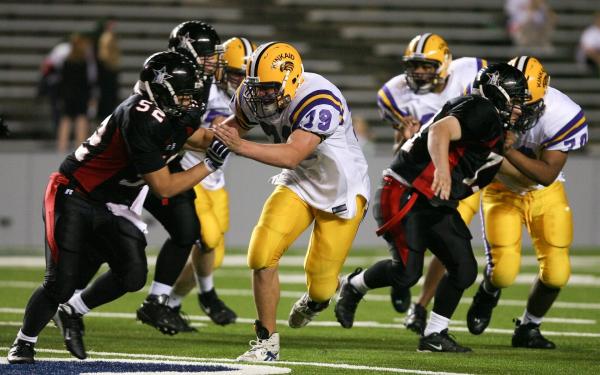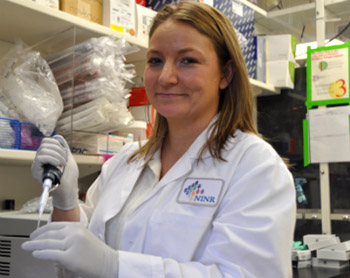On the Cusp of Customized Concussion Care
Five Questions With Dr. Jessica Gill

Concussions are a common injury in sports like football and hockey. Research led by IRP senior investigator Jessica Gill could help tailor individualized recovery plans for athletes with concussions.
Each year, millions of Americans suffer sports-related concussions, and the number of youth suffering from these traumatic brain injuries has been rising. Blows to the head are common in sports such as football and hockey, and when these forces are strong enough to cause a concussion, they can harm the brain and impair cognitive functioning. Although concussions occur in staggering numbers, scientists do not fully understand what happens to the brain at the time of concussion or during the recovery period. However, that doesn’t mean they’re not trying.
A 2017 study by IRP senior investigator Jessica Gill, Ph.D., R.N., showed that a molecule called tau that can be detected in the blood serves as a predictor of recovery time for those suffering from a concussion. Dr. Gill and her team found that concussed athletes with higher concentrations of tau needed more recovery time than those who had lower amounts. From these findings, Dr. Gill has gone on to expand her research in collaboration with the National Collegiate Athletic Association (NCAA) with the aim of providing personalized recovery care for athletes and others suffering with concussions.
In recognition National Youth Sports Week, as well as the rising numbers of sports-related concussions in the youth population, I spoke with Dr. Gill to discuss her research on tau, what it could mean for personalized concussion treatment, and how her research has evolved over the past couple years.
What prompted you to study sports-related concussions?
“My area of research has always been around brain trauma. Specifically, I study why some people recover from traumatic brain injuries and why others do not. From there, my interest expanded to also include concussions. I find this topic very interesting because each individual’s risk of concussion is unique — it varies from person to person. I believe that capturing an individual’s risk profile is the most important thing for treatment.
“In order to capture a person’s risk profile, my team uses biomarkers, such as tau, to understand why some people are more at risk of developing concussions than others. Through this research, we’re hoping to gain an objective understanding of why a patient would or wouldn’t recover, as well as figure out how to identify individuals who will not recover and how to optimize their care.”
What impact has your research on post-concussion tau levels in the blood had to-date?
“Our 2017 paper was one of the first to study this topic, and we’ve had the opportunity to build on the research we conducted in larger studies. For example, we’re now working with the NCAA Care Consortium to expand on our research. We’re excited because that study has enrolled 33,000 athletes and includes sites to collect blood samples from them for examination.
“I believe that initial paper was really just the tip of the iceberg on how biomarkers can be used to shape individualized care. The research has had an impact on the scientific community and concussion research in showing that we have the ability to detect very subtle brain injuries by examining the blood.
“Before conducting this study, people would say ‘You’ll never see anything’ or ‘That doesn’t matter,’ but by actually producing findings that relate to bodily systems and outcomes, we’ve shown that it does matter, and it opens the door to many options and future research.”

IRP senior investigator Jessica Gill in the lab
What collaborations did you use to conduct this research?
“The challenge of understanding very complex, subtle brain changes by using blood is very difficult. Due to that difficulty, we’ve collaborated with others at the NIH to include brain imaging in our studies. Having this collaboration has given us the opportunity to look at the brain when we see something in the blood. The ability to do so has been very helpful in identifying risk profiles. In addition to brain imaging, we’re also integrating with experts on balance and neurocognitive functions to give more depth to our data. While collaborating with teams at the NIH, we also are working with clinical experts, like those at the NCAA Care Consortium, who are on the ground meeting with the athletes and collecting data.
“Overall, I think that it is a really exciting time for the study of sports concussion. Everyone is coming together to address this complex problem in an innovative way. It’s this type of collaboration that makes the data collected so much more powerful.”
What was the most challenging aspect of that 2017 study?
“When we first started the study, we thought that our major finding would be brain-specific. However, when looking at the data, we found that wasn’t the case at all. We saw that blood levels of the tau protein actually went down over time in concussed athletes who participated in the study. This finding was surprising because it was completely counterintuitive to what we believed would happen.
“Since publishing the findings, other researchers have said that they had seen the same thing. This case shows that it’s okay to have wonky data or data you weren’t anticipating. Having this type of data and can actually lead to new discoveries. In this study, the data led us to conduct more in-depth studies. Specifically, we are now able to understand where the tau protein comes from by utilizing a new protocol to study tiny biological capsules called exosomes in the blood in order to identify what in the blood comes from the brain and what comes from muscle. The wonky data led us down that path.”
What failures did you face along the way?
“Every time I try to predict the outcome of a study, I’m wrong. However, it’s alright to be wrong, and it can lead you down new and exciting paths, which is what happened in this study.
“Our lab is open to failure, and we follow the data wherever it leads as long as it has a potential clinical application. We’re always focused on what the biomarkers mean and how they relate to clinical care for athletes and other populations. The ‘failures’ in this study helped us to go down different routes such as examining athletes’ exosomes and sweat to gain a greater understanding of concussion risk and recovery.
“I believe that you find the most exciting avenues and discoveries when your data isn’t what you had expected it to be.”
How are you planning to expand on your research in the future?
“After expanding our initial research in collaboration with the NCAA Care Consortium, we now are studying athletes who wear sweat patches during their concussion recovery period. This patch allows us to collect proteins, like tau, over a longer period of time so the team can observe what is being released from the brain while a person is recovering from a concussion.
“In addition to the sweat patch, we can now also observe hormones in an effort to understand how gender and hormonal balances impact recovery. In our first study, we had a small cohort of about 40 people. Now, our NCAA study includes thousands, allowing us to gain a robust amount of data on how hormones impact recovery. From our data, it seems that women are more likely to have a prolonged recovery. We’re now looking into what that really means, what symptoms they’re having and how it’s impacting their recovery.
“We also are working with our collaborative partners to collect samples instantly after an athlete is diagnosed with a concussion, as that seems to be the best predictive timepoint for data. From there, we’re hoping to identify and develop individualized point-of-care tasks, such as rest time. We’re also looking into studies with athletes who have had problematic concussion outcomes. We’re hoping to bring them to the NIH for advanced imaging to understand what is going on in their brains.”
Head over to our Accomplishments page for more information on Dr. Gill’s research, and subscribe to our weekly newsletter to stay up-to-date on the latest breakthroughs in the NIH Intramural Research Program.
Related Blog Posts
This page was last updated on Wednesday, May 24, 2023
